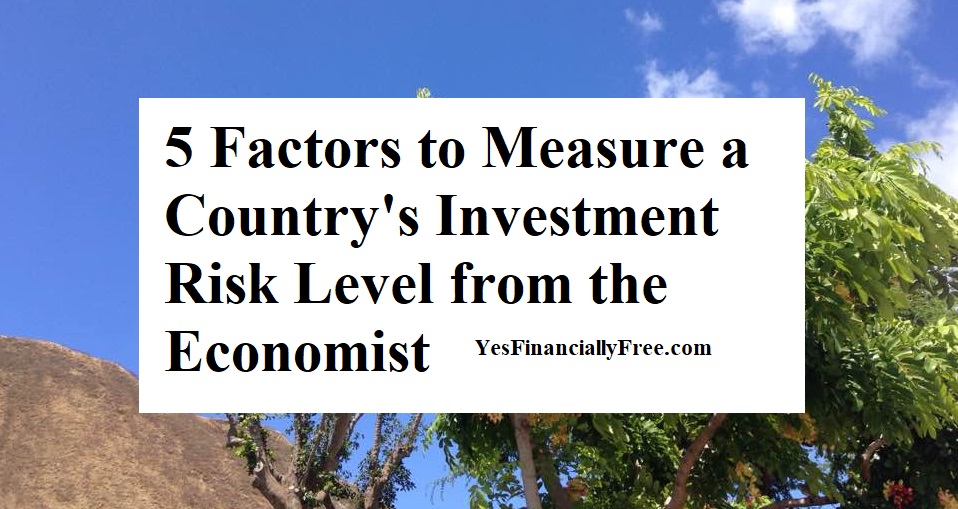
5 Factors to Measure a Country’s Investment Risk Level from the Economist
Today we are discussing 5 Factors to Measure a Country’s Investment Risk Level from the Economist.
My name is Mey Duldulao and I live in Honolulu, Hawaii with my husband Jomel and our now 7 year old son Jordan.
Back in 2011 I had more debt than I made a year in my salary, about $40,000.
I paid it all of in April of 2016, was making almost $500/mo in passive income from investments and quit my job.
I started coaching clients on what I did (CLICK HERE for coaching programs), started creating and building our own businesses (CLICK HERE for our AirBnB business), and more importantly, became a FULL TIME MOMMY AND WIFE.
I’m all about time freedom, living and ENJOYING the moment and have the time and energy to enjoy family and friends and great health.
So, back to the topic at hand, how to measure a country’s risk level.
I’m investigating this because of Ray Dalio’s advice from my last blog, where is recommends investing globally.
I got access to The Economist’s report of how they evaluate risk from my Schwab brokerage account.
You can also pay for the reports that The Economist issues as well.
#1 Sovereign Risk
They start with sovereign risk, which means, is the country likely to pay back it’s debts.
If you buy U.S. treasury bonds, is the country going to pay you interest and pay back the bond principal as well?
Is the country good for the money?
Have they ever not paid back their bonds or stopped paying interest?
#2 Currency Risk
The Economist figures out currency risk by evaluating whether the currency will drop in value by over 25% compared to the US dollar or the Euro.
Is the country’s money going to lose it’s value?
Sometimes countries will devalue their money on purpose to make their goods less expensive, and encourage other countries to buy their products (from investopedia article on 3 reasons for devaluing currency).
Some of the factors influencing the value of currency are inflation, interest rates, making money by selling goods to other countries, borrowing money to buy foreign goods, whether the country pays it’s debts, economic performance, political stability or instability (from investopedia article on 6 factors that influence exchange rates).
#3 Banking Sector Risk
Is there going to be a bank crisis or are banks going to be ok.
They are looking to see if banks that comprise of 10% or more of the banking assets of the country are going to go bankrupt.
I recall back in the late 90’s when I was living in Taiwan, there was an influx of immigrants from Indonesia.
One of the girls I met used to work in a bank, but the bank went out of business.
She told me it was because of the government which leads to the next risk factor.
#4 Political Risk
Political risk is about the government.
Who’s in charge of the country?
Is there fair rule, or is the government corrupt and abusive?
Are the leaders honest and are they effective?
Warren Buffet said in his biography that he invests in people.
If a company has good management, then it will be a good company.
The same is true of families, and countries.
#5 Economic Structure Risk
What do the people in the country buy and sell?
What do they produce?
What kind of commercial activities are taking place?
Are they an agricultural society?
Do they have natural resources that are in high demand such as gold, natural gas, copper, diamonds and so on.
Do they manufacture cars, equipment, semi-conductors and so on?
Are they creating information technology products?
Are they innovating?
How is their supply and demand?
How is the unemployment?
How is their economy structured?
Conclusion
I hear the word “invest globally” and I need to break it down in terms that make it easier for me to understand.
Even The Economist’s report on these factors was hard for me to understand. It took me hours of searching through definitions and other articles to comprehend it.
Basically, looking at the risk level of a country is the same process as looking at the risk level of investing in a company or a family.
In the case of a family, let’s say you have a married couple and they want to buy a house.
Do you lend them the money for the mortgage?
Well, you could look at the 5 factors this way:
#1 Do they pay back their debts? Are they good for the money?
#2 Is their money good? Are they borrowing money? Are they going to pay you in Bitcoin, USD or some other currency? Do they have cash reserves?
#3 Do they keep their money safe and is it easy to access?
#4 Do they get along, is their marriage strong? How do they work out their differences? Is there a balance of power?
#5 How do they make money? What do they spend their money on?
I hope this article helps you understand ways to evaluate a country’s investment risk.
If you have any comments, insights or want to share your own thoughts, please leave a comment below!